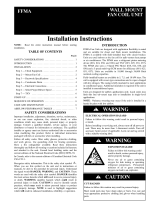
13
Turn on power supply. Set thermostat fan switch to on. Set the cool-
ing indicator to maximum, heating to minimum. System switch may
be on heat or cool. Check slope gauge measurement against appro-
priate air ow chart. Make damper, register and motor speed adjust-
ments to obtain required airow.
Set thermostat fan switch to auto, system to heat and thermostat
heating indicator to maximum heat. Blower should start and all heat
be energized.
Check air ow using temperature rise method.
17. Checking Air Flow/Temperature Rise Method
Table 16-1. - CFM Delivered at Various External Statics
CFM
=
Note: BTUH output should be computed by 500 x Gallons Per Min-
utes x System Temperature Change = BTUH OUTPUT.
8. Adjust the water heater thermostat so that the water temperature
entering the hot water coils is 120 – 180ºF depending on the amount
of heat required by the structure. This is done with the unit energized
and operating long enough for all temperatures to stabilize.
After all connections are made, start-up and check-out must be per-
formed before proper evaluation of the entire system can be made.
Make sure that heat anticipator is properly set as noted on thermo-
stat instructions.
Load requirements can vary in each residence and it may be neces-
sary for the installer or homeowner to make slight adjustments to the
heat anticipator setting for longer or shorter cycles. It is recommend-
ed to change the setting no more than plus or minus 0.05 amps at
a time. Greater changes can cause the unit to rapid cycle or remain
on excessively. To properly check the unit’s operation, the installer
should have an electrical current measuring device (0-10 amp Am-
probe, Fluke), air pressure measuring device (0-1.0 in slope gauge),
and a temperature-measuring device (0-200ºF thermometer).
Install the Amprobe to measure blower current, the slope gauge to
measure static air pressure at the units and the temperature device
to measure unit supply and return air temperature. Before taking
measurements, be sure that all registers, grilles and dampers are
open or are set to their proper positions. Be sure that clean lters are
in place. Temperature measuring device must be installed to obtain
average temperature at both inlet and outlet. For outlet, measure
temperature of each main trunk at a location far enough away to
avoid heater radiation and read the average temperatures. Table
16-1 below shows the CFM that should be achieved at various exter-
nal static pressures.
Below are brief descriptions of the key components of the unit and in-
stallation. This manual only provides general idea of the components
and recommended practices. The installer should use best judge-
ment to ensure safe installation and operation of the unit.
1. Room Thermostat- This is the device that controls that operation
of your heating and/or cooling unit. It senses the indoor temperature
and signals the equipment to start or stop maintaining the tempera-
ture you have selected for your comfort. The room thermostat should
be in a central, draft free inside wall location for best operation. Do
not place any heat producing apparatus such as lights, radio, etc.,
near the thermostat as this will cause erratic operation of the comfort
system. The thermostat can accumulate dust or lint which can affect
its accuracy. It should be cleaned annually.
2. Air Filter(s) - All central air moving comfort systems must include
air lter(s). These lters will be located either in the equipment or in
the return air duct system upstream of the equipment. The lter(s)
removes dust and debris from the air thus helping to keep your air-
conditioned space clean. More important, the lter keeps dust and
debris from collecting on the heat transfer surfaces thus maintaining
optimum equipment efciency and performance. Inspect and clean
or replace lters every month. This routine maintenance procedure
will pay big dividends in reduced operating cost and reduced service
expense. Never operate comfort equipment without lter(s).
3. Fuses and/or Circuit Breakers- This comfort equipment should be
connected to the building electric service in accordance with local
and National Electric codes. This electrical connection will include
over-current protection in the form of circuit breakers. Have your
contractor identify the circuits and the location of over-current protec-
tion so that you will be in a position to make inspections or replace-
ments in the event the equipment fails to operate.
18. Operation and Maintenance
5. Periodic Checkup and Service- This product is designed to pro-
vide many years of dependable, trouble-free comfort when properly
maintained. Proper maintenance will consist of annual check-ups
and cleaning of the internal electrical and heat transfer components
by a qualied service technician. Failure to provide periodic checkup
and cleaning can result in excessive operating cost and/or equip-
ment malfunction.
6. Lubrication- Direct drive blower motors are equipped with perma-
nently lubricated bearings and do not require further lubrication.
7. Air lter replacement: An air lter can restrict the airow of air to
the fan coil if it is not cleaned or replaced periodically. When replac-
ing the air lter, always replace with the same type and size as origi-
nally furnished with the unit.
4. a) Do not store combustible materials
or use gasoline or other ammable liquids
or vapors in the vicinity of this appliance.
b) Do not operate the comfort equipment with panels re-
moved.
c) Have your contractor point out and identify the various
cut-off devices, switches, etc., that serve your comfort
equipment. There is a main switch that will cut off energy to
your heating system. Know where they are so that you may
cut off the ow of energy in the event of overheating.
!
WARNING
23/24
35/36
47/48/60





















